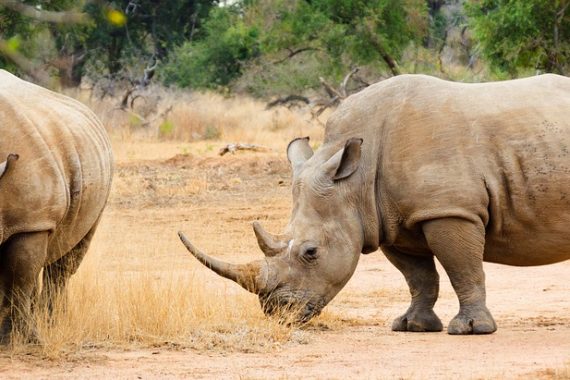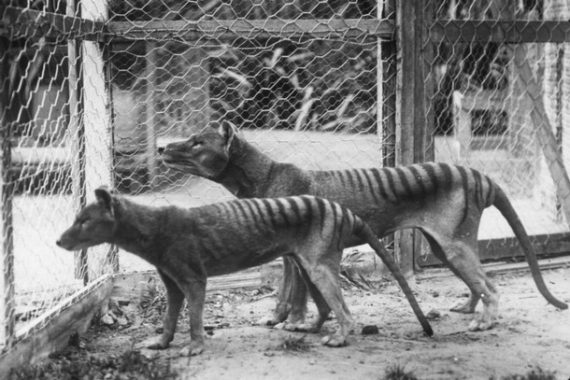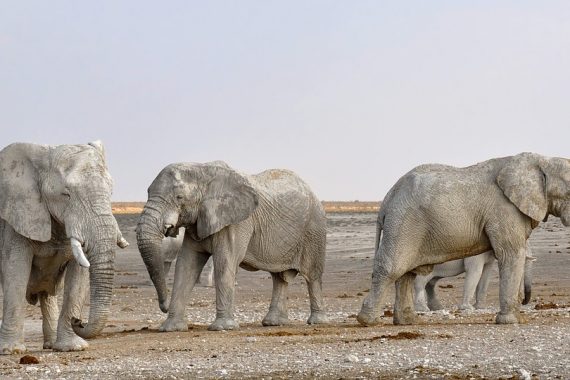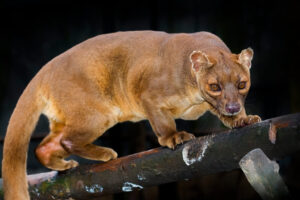
The fantastical fossa (image from San Diego Zoo)
Madagascar is home to some pretty amazing and unique creatures, and the fabulous fossa is no exception. The largest mammalian carnivore in Madagascar, the fossa looks like a cross between a cat and a weasel, and has the agility of a lemur, which is handy, since its primary prey is lemurs.
First described in 1833 by Edward Turner Bennet, a British zoologist, who first placed the fossa along with the civets. However, when specimens were closely examined, taxonomists found that the fossa has retractable claws, large eye sockets and specialised carnivorous dentition, and placed the fossa closer to the felids. In reality, the fossa are nowhere close to felids, and these anatomical features are an example of convergent evolution, in which the same features evolve in completely different species in distant locations.
By 1939, scientists had decided the best place for the unique fossa was in its own subfamily within Felidae, called cryptoproctinae, where it remained until 1993, where huge scientific advances enabled the study of fossa DNA. This study determined that the fossa was closer to mongooses than to cats or civets. In 2003, further molecular studies found that all carnivores inhabiting Madagascar share one common ancestor, excluding family ties to all other carnivores and making the fossa even more unique than first thought. At some point in distant history, a mongoose like carnivore found its way over from Africa to Madagascar, finding an abundant supply of lemur prey and absence of other, larger carnivores. No one knows much about these fossa ancestors; only one extinct relative has ever been found in the fossil record, a much larger fossa called Cryptoprocta spelea.
Today, all Malagasy carnivores are classified into one single family, Eupleridae, which has eight still living members, with the fossa in the subfamily Euplerinae.
The high-flying life of the fossa
Fossa are generally solitary animals, although they will be seen in pairs around breeding season. However, some researchers have recorded fossa cooperatively hunting a sifaka, a large lemur, for around 45 minutes, before finally bringing the prey down and sharing it amongst the group. This may be a vestige of the hunting behaviour that was needed in generations long past to hunt lemurs when they were much larger than they are today. Fossa will also hunt rodents and reptiles.
As the largest endemic predator on Madagascar, the fossa is a very important part of the healthy functioning of the unique ecosystems existing on the island. Fossa are incredibly agile and spend their time moving between the ground and the tree canopy with ease, with their incredibly long tails and hyperflexible limbs helping them to swing between trees and balance on thin branches. Fossa don’t prefer a time of day to hunt; they are what is known as cathemeral, meaning they are active any time of the day or night. Given how flexible their behaviour and diet is and their importance as a top predator, some scientists are now considering classifying the fossa as a keystone species. We’ve covered many keystone species on the podcast, and they are defined as any species that are essential to the healthy functioning of any ecosystem, occupying an essential niche. Putting the fossa into this category could be a real boost for conservation efforts for this unique animal.
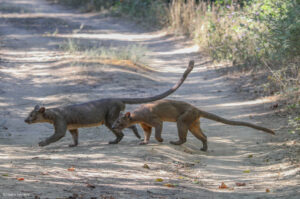
A clear example of how long the Fossa’s tail is, perfect for helping them balance as they race through trees after their agile lemur prey (image from africageographic.com)
Fossa have some rather unusual anatomy, and not just the amazing musculature that enables to leap from one tree to another chasing lemurs. Fossa also possess some pretty bizarre genitalia. For the males, they have a penis and a baculum (the bone that runs through the penis of many placental mammals) that is so long it can reach down between the forelegs! And its just not the males who are unusual, females also display a phenomenon known as transient masculinisation. Young females develop enlarged genitalia that resemble a males’ penis. As the females grow, this decreases in size over time. No one is exactly sure that the purpose of this process is, but behavioural scientists hypothesise that it reduces harassment of juvenile females by adult males, or possibly may reduce aggression from territorial females.
Fossas in fragmented forests: threats in Madagascar
Fossas are naturally rare animals, occurring at very low densities, but their populations are currently facing several threats that could shrink their numbers to dangerously low levels.
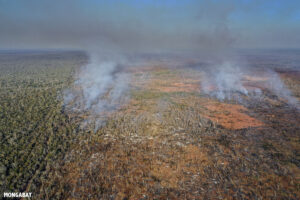
The devastating deforestation caused by slash and burn agriculture in Madagascar (image from WildMadagascar.org)
Deforestation is a major issue throughout Madagascar. From a study published in 2023 it was determined that around 4.85 million hectares of tree cover have been lost since 2000, which is around 25% of forest gone. 90% of wildlife, including the fossa, are endemic to Madagascar, and the island is one of the most biodiverse hotspots in the world. Almost all species rely heavily on good quality forest habitat, and so this level of deforestation, usually by the devastating slash and burn agriculture, is a serious concern for conservation in Madagascar.
The fossa is also a frequent victim of hunting, either for food, or in retaliation for their predation on villager’s livestock. They do often take poultry as they are easy prey, and this behaviour will only increase as forests become increasingly fragmented and their prey base begins to shrink. There are also threats from domestic dogs who may spread disease or compete with them for food. Some villages perceive the fossa as a dangerous predator, capable of taking pigs and even small children, and may kill them on sight out of fear. They are pretty scary if you’re a lemur, but humans have little to fear from them.
Conservation optimism
Fossa could be considered a somewhat neglected species; there is still great deal about them that we don’t know, and therefore we don’t know the best ways to conserve them. However, they are currently listed as an EDGE species, part of the evolutionarily distinct and globally endangered programme developed by London Zoo, and this provides funding for scientists interested in conserving the fossa. Conservation aims for the fossa includes a full scale survey of fossa populations on Madagascar, a vital piece of data which is currently lacking. Education is also essential, changing the attitudes of local people towards the fossa and showing them in a better light than how they are usually perceived. The provision of ecotourism is also essential for the fossa’s future, as it makes conservation interventions a more viable option for locals, who can have access to employment opportunities to life themselves out of the crushing poverty that is all too common on Madagascar. Tours to visit lemurs, fossas, aye ayes, tenrecs and many more of the amazing animals that have evolved on Madagascar could be an excellent way to provide employment to locals and conserve the fossa, all in one go.
Fossa do exist in some protected parks, such as Ranomafana, Masaola and Ankarafantsika, but there are insurance populations in place if the worst should happen. There is a successful captive breeding programme in place that first started in 1974 at the Montpelier Zoo in France. Duisburg Zoo in Germany holds a population of fossa that have been essential for research, and most fossa in captivity today are descended from this population. To really safeguard the future of the fantastic fossa, the forests of Madagascar need to be better protected. The world wildlife fund are one of the organisations leading the fight for the future of Madagascar, and you can learn more about their amazing work here : Madagascar | Animals, People, and Threats | WWF (worldwildlife.org), and find out how you can help from wherever you are in the world.
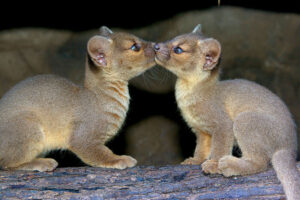
Two super cute Fossa pups, born as part of the international breeding programme at San Diego Zoo (image from San Diego Zoo)
Awesome videos!
References
Gerber, B.D. Karpanty, S.M. and Randrianantenaina, J. (2012) ‘The impact of forest logging and fragmentation on carnivore soecues composition, density an occupancy in Madagscar’s rainforest.’ Oryx
Goodman, S.M. Rasoloarison, R.M. and Ganzhorn, J.U. (2004) ‘On the specific identification of subfossil Cryptoprocta from Madagascar.’ Zoosystema
Hawkins, C.E. and Racey, P.A. (2005) ‘Low population density of a tropical forest carnivore, Cryptoprocta ferox: implications for protected area management.’ Oryx
Suzzi-Simmons, A. (2023) ‘Status of deforestation on Madagascar.’
Veron, G. and Catzeflis, F.M. (1993) ‘Phylogenetic relationships of the endemic Malagasy carnivore Cryptoprocta ferox: DNA/DNA hybridization experiments. Journal of Mammalian Evolution
Yoder, A.D. and Flynn, J.J. (2003) ‘Origin of Malagasy Carnivora.’ The Natural History of Madagascar
MASSIVE THANK YOU TO RACHAEL DA SILVA FROM THE UK FOR THIS WRITE UP! PLEASE FOLLOW HER ON INSTAGRAM AND HER WILDLIFE ARTWORK AT TILLY_MINT08


